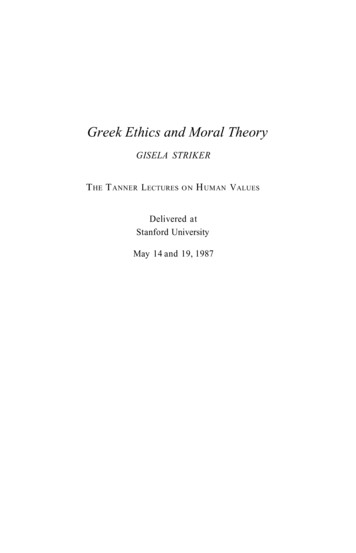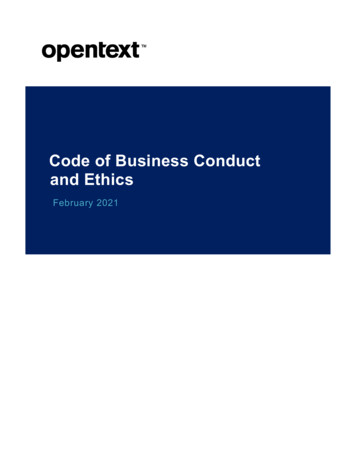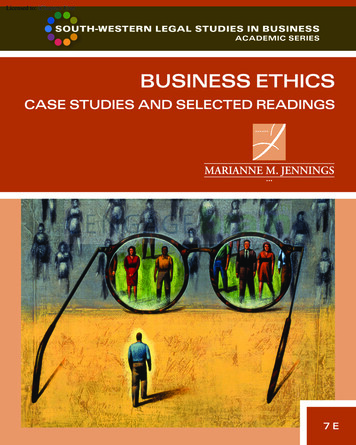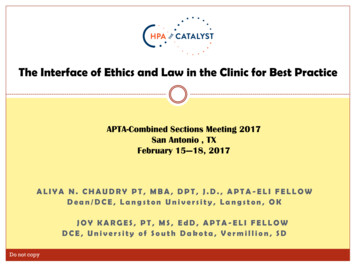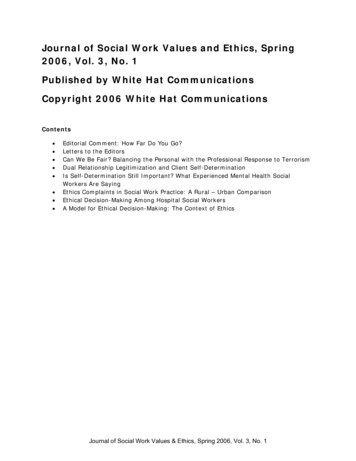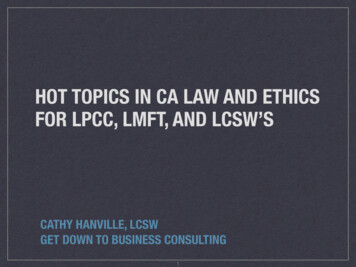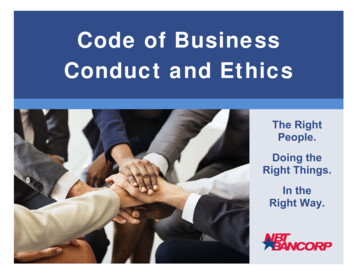
Transcription
Ethics and theConduct of BusinessEighth EditionJohn R. BoatrightLoyola University ChicagoJeffery D. SmithSeattle UniversityBoston Columbus Indianapolis New York City San FranciscoAmsterdam Cape Town Dubai London Madrid Milan Munich Paris Montréal TorontoDelhi Mexico City São Paulo Sydney Hong Kong Seoul Singapore Taipei Tokyo
Editor in Chief: Ashley DodgeProgram Team Lead: Amber MackeyManaging Editor: Sutapa MukherjeeProgram Manager: Carly CzechSponsoring Editor: Bimbabati SenEditorial Project Manager: Janet Wehner, AptaraDevelopment Editor: Sue M. Park, AptaraEditorial Assistant: Casseia LewisDirector, Content Strategy and Development: Brita NordinVP, Director of Marketing: Maggie MoylanDirector of Field Marketing: Jonathan CottrellSenior Marketing Coordinator: Susan OsterlitzDirector, Project Management Services: Lisa IarkowskiPrint Project Team Lead: Vamanan NamboodiriProject Manager: Pooja AggarwalOperations Manager: Mary FischerOperations Specialist: Carol Melville/Mary Ann GloriandeAssociate Director of Design: Blair BrownInterior Design: Kathryn FootCover Art Director: Maria LangeCover Design: Heather Marshall, Lumina Datamatics, Inc.Cover Art: 孤飞的鹤/FotoliaDigital Studio Team Lead: Peggy BlissDigital Studio Project Manager: Liz Roden HallDigital Studio Project Manager: Elissa Senra-SargentFull-Service Project Management and Composition: Jogender Taneja, iEnergizer Aptara , Ltd.Printer/Binder: CKCover Printer: PhoenixAcknowledgements of third party content appear on page 380, which constitutes an extension of thiscopyright page.Copyright 2017, 2012, 2009 by Pearson Education, Inc. or its affiliates. All Rights Reserved. This digitalpublication is protected by copyright, and permission should be obtained from the publisher prior to anyprohibited reproduction, storage in a retrieval system, or transmission in any form or by any means, electronic,mechanical, photocopying, recording, or otherwise except as authorized for use under the product subscriptionthrough which this digital application is accessed. For information regarding permissions, request forms andthe appropriate contacts within the Pearson Education Global Rights & Permissions department, please visitwww.pearsoned.com/permissions/.PEARSON, ALWAYS LEARNING, and REVEL are exclusive trademarks owned by Pearson Education, Inc.,and its affiliates in the U.S. and/or other countries.Unless otherwise indicated herein, any third-party trademarks that may appear in this work are the property oftheir respective owners and any references to third-party trademarks, logos or other trade dress are for demonstrative or descriptive purposes only. Such references are not intended to imply any sponsorship, endorsement,authorization, or promotion of Pearson’s products by the owners of such marks, or any relationship betweenthe owner and Pearson Education, Inc. or its affiliates, authors, licensees or distributors.Library of Congress Cataloging-in-Publication DataNames: Boatright, John Raymond, 1941– author. Smith, Jeffery David, 1971– author.Title: Ethics and the conduct of business / John R. Boatright, LoyolaUniversity Chicago, Jeffery D. Smith, Seattle University.Description: Eighth edition. Boston: Pearson, [2017]Identifiers: LCCN 2015050453 ISBN 9780134167657 ISBN 0134167651Subjects: LCSH: Business ethics. Social responsibility of business.Classification: LCC HF5387 .B6 2017 DDC 174/.4—dc23 LC record available athttp://lccn.loc.gov/201505045310 9 8 7 6 5 4 3 2 1ISBN-10:0-13-416765-1ISBN-13: 978-0-13-416765-7
Brief Contents1Ethics in the World of Business192Ethical Decision Making213Ethical Theories4Health and Safety18210Marketing and Advertising2084611Ethics in Finance239Whistle-Blowing6512Corporate Social Responsibility2685Business Information and Conflictof Interest8213Governance, Accountability,and Compliance2976Privacy14International Business Ethics3257Discrimination and AffirmativeActionEmployment Rights8106References357133Credits380156Index387iii
This page intentionally left blank
ContentsPrefaceAbout the Authors1ixxiEthics in the World of Business1Case: Merck and the Marketing of Vioxx11.1: Business Decision Making1.1.1: Nature of Business1.1.2: Levels of Decision Making4561.2: Ethics, Economics, and Law1.2.1: Ethics and Economics1.2.2: Ethics and Law7791.3: Ethics and Management1.3.1: Ethical Management and Managementof Ethics1.3.2: Ethics and the Manager’s Role11121.4: Ethics in Organizations1.4.1: Individual Decision Making1.4.2: Organizational Decision Making131415Conclusion: Ethics in the World of Business1116Case: A Sticky SituationCase: Beech-Nut’s Bogus Apple JuiceCase: Ethical Uncertainty at Bath Iron Works3Case: Big Brother at Procter & GambleEthical Decision MakingCase: HP and the Smart Chip464848503.2: Kantian Ethics3.2.1: Universalizability3.2.2: Respect for Persons5252533.3: Virtue Ethics3.3.1: What Is Virtue?3.3.2: Defending the Virtues3.3.3: Virtue in Business535454553.4: Rights3.4.1: Meaning of Rights55553.4.2: Kinds of Rights3.5: Justice3.5.1:3.5.2:3.5.3:3.5.4:Nature and Value of JusticeAristotle on Distributive JusticeRawls’s Egalitarian TheoryNozick’s Entitlement TheoryConclusion: Ethical Theories56575758595960Case: Exporting Pollution21Case: Clean Hands in a Dirty Business21Case: An Auditor’s Dilemma2.1: Market Ethics2.1.1: The Market System2.1.2: Ethics in Markets2.1.3: Breaches and Fraud2.1.4: Wrongful Harm2.1.5: Market Failure2.1.6: Summary of Market Ethics222224252627302.2: Roles, Relationships, and Firms2.2.1: Agents and Principals2.2.2: Fiduciaries and Professionals2.2.3: Firms2.2.4: Summary of Roles, Relationships,and Firms303131322.3: Ethical Reasoning2.3.1: Philosophical Accounts2.3.2: Psychological Accounts2.3.3: Framework for Reasoning35363738Conclusion: Ethical Decision Making463.1: Utilitarianism3.1.1: Principle of Utility3.1.2: Cost–Benefit AnalysisCase: A Faked Résumé at Yahoo2Ethical Theories3541Case: Conflict of an Insurance Broker4Whistle-BlowingCase: Time’s Persons of the Year65654.1: What Is Whistle-Blowing?674.2: Justification of Whistle-Blowing4.2.1: Loyal Agent Argument4.2.2: Meaning of Loyalty4.2.3: Conditions for Justification696971714.3: Right to Blow the Whistle4.3.1: Existing Legal Protection4.3.2: Arguments against Protection4.3.3: Arguments for Protection737375754.4: Developing a Policy4.4.1: Benefits and Dangers4.4.2: Components of a Policy767676Conclusion: Whistle-Blowing77Case: Lavish Pay at HarvardCase: A Whistle-Blower Accepts a “Deal”Case: Broken Trust at Bankers TrustCase: A Whistle-Blower’s QuandaryCase: KPMG’s Tax Shelter BusinessCase: Who’s a Whistle-Blower?v
vi Contents5Business Information and Conflictof InterestCase: Privacy of Text MessagesCase: Barbie vs. the Bratz Girls825.1: Confidential Information5.1.1: Duty of Confidentiality5.1.2: Competitive Employment5.1.3: Impact of Restrictions848586875.2: Proprietary Information5.2.1: Intellectual Property5.2.2: Defining Trade Secrets5.2.3: Property Rights Argument5.2.4: Fair Competition Argument5.2.5: Competitor Intelligence8888899091925.3: Conflict of Interest5.3.1: Defining Conflict of Interest5.3.2: Some Relevant Distinctions5.3.3: Kinds of Conflict of Interest5.3.4: Managing Conflict of Interest9395959698Conclusion: Business Information and Conflictof Interest102Case: The Aggressive Ad AgencyCase: Procter & Gamble Goes Dumpster DivingCase: A Conflict-Laden Deal6PrivacyCase: Psychological Testing atDayton Hudson1061066.1: Challenges to Privacy6.1.1: Privacy in the Workplace6.1.2: Privacy in the Marketplace1081081096.2: Meaning and Value of Privacy6.2.1: History of the Concept6.2.2: Defining Privacy6.2.3: Utilitarian Arguments6.2.4: Kantian Arguments1101111111121136.3: Privacy Away from Work6.3.1: Justifying Monitoring6.3.2: Limits to Monitoring1141141156.4: Privacy of Employee Records6.4.1: Ethical Issues with Records6.4.2: Justifying a Purpose6.4.3: Disclosure to Outsiders6.4.4: Gathering Information6.4.5: Accuracy, Completeness, and Access1161171171181191206.5: Big Data Analytics6.5.1: Data Collection6.5.2: Ethical Issues with Big Data1201211226.6: Using the Internet6.6.1: Information Collection6.6.2: Ethical Issues with Internet Use6.6.3: Protecting Privacy123123124125Conclusion: PrivacyCase: Plugging Leaks at HP82128Case: Information Handling at ChoicePoint7Discrimination andAffirmative ActionCase: Race Discrimination at Texaco1331337.1: What Is Discrimination?7.1.1: Civil Rights Act of 19647.1.2: Disparate Treatment/Impact7.1.3: Forms of Discrimination1351351361377.2: Sexual Harassment7.2.1: Defining Sexual Harassment7.2.2: Forms of Sexual Harassment7.2.3: Further Issues1381381391407.3: Objections to Discrimination1407.4: Preventing Discrimination7.4.1: Analysis, Recruitment, and Assessment7.4.2: Objective Tests7.4.3: Subjective Evaluations7.4.4: Sexual Harassment Programs1421421421431447.5: Affirmative Action7.5.1: Affirmative Action Plans7.5.2: Court Actions on Plans7.5.3: Compensation Argument7.5.4: Equality Arguments7.5.5: Utilitarian Arguments7.5.6: Problems with Affirmative Action145146146147149150151Conclusion: Discrimination and Affirmative Action152Case: Jacksonville ShipyardsCase: Sex Discrimination at Walmart8Employment RightsCase: The Firing of Robert Greeley1561568.1: Employment at Will8.1.1: Property Rights Argument8.1.2: Freedom of Contract Argument8.1.3: Efficiency Argument8.1.4: Exceptions1571581591601618.2: Right to Due Process8.2.1: Support for Due Process8.2.2: Law of Due Process1621631638.3: Freedom of Expression8.3.1: Defining Freedom of Expression8.3.2: Legal Protection for Expression8.3.3: Arguments over Expression1641651651668.4: Workplace Democracy8.4.1: Participation and Democracy8.4.2: Arguments for Democracy1671671688.5: Worker Compensation8.5.1: Setting Wages169170
viiContents10.6: Irrational Persuasion10.6.1: Threats to Free Choice10.6.2: Dependence Effect22422522510.7: Impact of Advertising10.7.1: Impact on Persons10.7.2: Impact on Society226226228Case: Worker Participation at Saturn10.8: Internet Advertising10.8.1: Online Placement10.8.2: Ethics of Placement229229230Case: Health Benefits at Walmart10.9: Social Advertising2328.5.2: Market Outcomes8.5.3: Minimum Wage1701728.6: Executive Compensation8.6.1: Criticism of CEO Pay8.6.2: Justifying CEO Pay8.6.3: Problems with Justification173174174175Conclusion: Employment Rights176Case: Fired for Blogging at GoogleConclusion: Marketing and Advertising9Health and SafetyCase: The Ford–Firestone Brawl1821841841859.2: Hazardous Work9.2.1: Justifying a Right to Refuse9.2.2: Justifying a Right to Know1881891919.3: Reproductive Hazards9.3.1: Scientific Background9.3.2: Fetal Protection Policies9.3.3: Charge of Discrimination9.3.4: Defending against the Charge9.3.5: Remaining Issues1921931931941951959.4: Product Safety9.4.1: Due Care Theory9.4.2: Contractual Theory9.4.3: Strict Liability Theory196196198200Conclusion: Health and SafetyCase: Capital One’s Online Profiles1829.1: Rights in the Workplace9.1.1: Meaning of Health and Safety9.1.2: Protecting Health and Safety203Case: Herbalife: A Pyramid Scheme?11Ethics in Finance239Case: Goldman Sachs and the Abacus Deal23911.1: Financial Services24111.1.1: Deception24211.1.2: Churning24311.1.3: Suitability24411.2: Financial Markets24511.2.1: Fairness in Markets24611.2.2: Derivatives and HFT24811.3: Insider Trading25111.3.1: Theories of Insider Trading25211.3.2: Evaluation of the Two Theories25311.3.3: Recent Insider Trading Cases25411.4: Hostile TakeoversCase: Genetic Testing at Burlington NorthernCase: Johnson Controls, Inc.Case: The Collapsing Crib10233Case: McCormick’s Pricing Strategy25511.4.1: Market for Corporate Control25611.4.2: Takeover Tactics25711.4.3: Role of Directors260Conclusion: Ethics in Finance261Case: SCM Mutual FundsMarketing and AdvertisingCase: Selling Hope208Case: Merrill Lynch and the Nigerian Barge DealCase: Martha Stewart: Inside Trader?20810.1: Marketing Ethics Framework21010.2: Sales Practices and Labeling10.2.1: Deception and Manipulation10.2.2: Information Disclosure10.2.3: Labeling21221221321410.3: Pricing and Distribution10.3.1: Anticompetitive Pricing10.3.2: Unfair Pricing10.3.3: Distribution21521521721810.4: Development and Research10.4.1: Product Development10.4.2: Marketing Research21921922010.5: Deceptive Advertising10.5.1: Defining Deceptive Advertising10.5.2: Applying the Definition222222224Case: Oracle’s Hostile Bid for PeopleSoft12Corporate Social Responsibility268Case: Competing Visions at Malden Mills26812.1: The CSR Debate27012.1.1: Meaning of CSR27112.1.2: Examples of CSR27212.1.3: Related Concepts27312.2: Normative Case for CSR27412.2.1: Classical View27412.2.2: Friedman on CSR27612.3: Business Case for CSR27812.3.1: The Market for Virtue27812.3.2: Competitive Advantage280
viii Contents12.4: Implementing CSR12.4.1: Program Selection and Design12.4.2: Reporting and Accountability28128128312.5: Business with a Mission12.5.1: Social Enterprise12.5.2: Competing Successfully12.5.3: Mission and Trust285286287289Conclusion: Corporate Social Responsibility290Case: Starbucks and Fair Trade CoffeeCase: Timberland and Community ServiceCase: Coca-Cola’s Water Use in India13Governance, Accountability,and ComplianceCase: Fraud at WorldCom29729713.1: Corporate Governance13.1.1: Shareholder Control13.1.2: The Shareholders’ Contract13.1.3: Shareholders and Stakeholders29930030330513.2: Corporate Accountability13.2.1: Financial Reporting13.2.2: Executives and Directors13.2.3: Criminal Prosecution30730731031213.3: Corporate Compliance13.3.1: Program Components13.3.2: Program Benefits13.3.3: Federal Sentencing Guidelines13.3.4: Codes of Ethics313314314315317Conclusion: Governance, Accountability,and ComplianceCase: Sears Auto CentersCase: Shareholder Rights at Cracker BarrelCase: The Sale of Trans Union31914International Business EthicsCase: Mattel’s Toy Woes32532514.1: Different Standards14.1.1: Relevant Differences14.1.2: Variety of Outlooks14.1.3: Right to Decide14.1.4: Business Necessity32832932933033114.2: Guidelines for Multinationals14.2.1: Rights14.2.2: Welfare14.2.3: Justice14.2.4: International Codes33133233333333514.3: Wages and Working Conditions14.3.1: Setting Wages14.3.2: Working Conditions33633733914.4: Foreign Bribery14.4.1: What Is Bribery?14.4.2: What’s Wrong with Bribery?14.4.3: Combating Bribery34034134234314.5: Human Rights Abuses14.5.1: Constructive Engagement14.5.2: Liability for Abuses346347348Conclusion: International Business Ethics349Case: H. B. Fuller in HondurasCase: Walmart in MexicoCase: Google in ChinaReferencesCreditsIndex357380387
PrefaceThe eighth edition of Ethics and the Conduct of Business has reached two significant milestones. Thefirst achievement, which is obvious to anyone reading these words, is the transition to digital media. ThroughPearson’s online platform REVEL, this text offers not onlya new mobile reading experience—on computers, tablets,and even smartphones—but also a new approach to learning, with many interactive features, videos, quizzes, andother educational tools. REVEL creates a new frontier ineducation for both students and instructors. It is excitingfor us, as authors, to be pioneer participants in this promising and innovative endeavor.Users of previous editions will also note the appearance of a coauthor, Jeffery D. Smith. His collaboration inthe eighth edition not only brings a fresh perspective towhat is now a joint venture but also prepares for the futureof this classic text, which first appeared more than 20 yearsago. Under Jeffery’s guidance, Ethics and the Conduct ofBusiness will hopefully continue to remain current and relevant through many new editions.The eight editions of Ethics and the Conduct of Businesshave followed the development of the field of businessethics, which has grown in recent decades into an interdisciplinary area of study that has found a secure niche inboth liberal arts and business education. Credit for thisdevelopment belongs to many individuals—both philosophers and business scholars—who have succeeded inrelating ethical theory to the various problems of ethicsthat arise in business. They have shown not only that business is a fruitful subject for philosophical exploration butalso that future managers in the world of business can benefit from the results.Ethics and the Conduct of Business, eighth edition, is acomprehensive and up-to-date discussion of the mostprominent issues in the field of business ethics and themajor positions and arguments on these issues. It isintended to be used as a text in business ethics courses oneither the undergraduate or M.B.A. level. The substantialnumber of cases included provides ample opportunity fora case-study approach or a combined lecture–discussionformat. There has been no attempt to develop a distinctiveethical system or to argue for specific conclusions. Thefield of business ethics is marked by reasonable disagreement that should be reflected in any good text for a course.The focus of Ethics and the Conduct of Business is primarily on ethical issues that corporate decision makersface in developing policies about employees, customers,investors, and the general public. The positions on theseissues and the arguments for them are taken from a widevariety of sources, including economics and the law. Thestudy of ethical issues in business is not confined to a single academic discipline or even to the academic world. Theissues selected for discussion are widely debated by legislators, judges, government regulators, business leaders,journalists, and, indeed, virtually everyone with an interest in business.An underlying assumption of this course is that ethical theory is essential for a full understanding of the positions and arguments offered on the main issues in businessethics. Fortunately, the amount of theory needed is relatively small, and much of the discussion of these issuescan be understood apart from the theoretical foundationprovided here. The text also contains a substantial amountof legal material, not only because the law addressesmany ethical issues but also because management decision making must take account of the relevant law. Manyexamples are used throughout the text in order to explainpoints and show the relevance of the discussion to real-lifebusiness practice.New to the EditionPreparation of the eighth edition of Ethics and the Conductof Business has provided an opportunity to incorporatenew developments and to increase its value in the classroom. The major changes from the previous edition are asfollows: Chapter 5 on business information has been expandedto provide greater coverage on confidential informationand the duty of confidentiality. Chapter 6 on privacy has been expanded to includemore on the protection of both employee and consumerprivacy against intrusions, especially from advances intechnology. The section on product safety has been moved fromChapter 10 on marketing and advertising to the coverage of worker health and safety in Chapter 9. Thischange has allowed expanded treatment in Chapter 10of emerging issues in marketing and advertising, especially those related to the use of social media and dataanalysis, which have been facilitated by the Internet. Chapter 12 on corporate social responsibility includesa new section on the recent development of for-profitbusinesses, known as social enterprises, which operatewith a mission to deliver vital social services.ix
x Preface The Chapter 13 section on corporate governance has beencompletely rewritten for greater clarity and coherence. The eighth edition contains 58 short cases, including 12new ones on such subjects as a falsified résumé atYahoo, conflict of interest at Goldman Sachs, a firing atGoogle for blogging, profiling of Internet visitors by amajor bank, variable pricing strategies in grocery stores,Herbalife’s unusual multilevel marketing scheme,Coca-Cola’s water use in India, and bribery by Walmartexecutives in Mexico.AcknowledgmentsI, John Boatright, am grateful for the support of LoyolaUniversity Chicago and especially the Quinlan School ofBusiness. I have benefited from the resources of the RaymondC. Baumhart, S.J., Chair in Business Ethics, which wascreated to honor a former president of Loyola UniversityChicago, who was also a pioneer in the field of businessethics. To Ray Baumhart I owe a special debt of gratitude. Iam grateful as well to Jeffery Smith for graciously accepting my offer to become a coauthor of this edition and myultimate successor in the preparation of future editions.Finally, my deepest expression of appreciation goes to mywife, Claudia, whose affection, patience, and support havebeen essential for the preparation of the eighth edition, asthey were for the ones previous.It goes without saying that I, Jeffery Smith, am excitedto work with John Boatright on this important project andappreciate his generous offer to continue our collaborationon future editions. I hope to maintain the clarity, depth,and even-handedness that have made earlier editions sovaluable to students and instructors. For over a decade, Ihave benefited from the support of the Banta Center forBusiness, Ethics and Society and my colleagues at the University of Redlands. For everyone there I am grateful. Mythanks also go to DePauw University’s Prindle Institutefor Ethics for hosting me as the Nancy Schaenen VisitingScholar while portions of the eighth edition were written.And I also owe so much to my lovely wife, Rita, who provides support when I need it most and continues to keepme grounded.John R. BoatrightJeffery D. SmithI, John Boatright, would like to express my gratitudefor permission to use material from the following sources:John R. Boatright, Ethics in Finance, 2nd ed. (Malden,MA: Blackwell Publishers, 2008), copyright 1999,2008 by John R. Boatright; Ethics in Finance, 3rd ed.(Malden, MA: Wiley Blackwell, 2014), copyright 2014by John Wiley & Sons, by permission of the publisher.John R. Boatright, “Financial Services,” in MichaelDavis and Andrew Stark, eds., Conflict of Interest in theProfessions (New York: Oxford University Press, 1999),copyright 1999 by John R. Boatright.John R. Boatright, “Corporate Governance,” Encyclopedia of Applied Ethics, 2nd ed., Ruth Chadwick, ed.(Amsterdam: Elsevier, 2011), by permission of thepublisher.John R. Boatright, “The Shareholder Model ofCorporate Governance,” in Robert W. Kolb, ed., Encyclopedia of Business Ethics and Society (Thousand Oaks,CA: Sage Publications, 2008), by permission of thepublisher.
About the AuthorsJohn R. Boatright is the Raymond C. Baumhart, S.J., Professor of Business Ethics in the Quinlan School of Businessat Loyola University Chicago. He has served as the Executive Director of the Society for Business Ethics, and is apast president of the Society. He was recognized by theSociety in 2012 for a “Career of Outstanding Service to theField of Business Ethics.” He is the author of the book Ethics in Finance, and has edited Finance Ethics: Critical Issuesin Theory and Practice. He serves on the editorial boards ofBusiness Ethics Quarterly, Journal of Business Ethics, andBusiness and Society Review. He received his Ph.D. in philosophy from the University of Chicago.Jeffery D. Smith is the Boeing Frank Shrontz Chair of Professional Ethics and Professor of Management in theAlbers School of Business and Economics at Seattle University, teaching ethics to management, accounting andfinance students. He currently serves on the executiveboard of the Society for Business Ethics and the editorialboard of the international journal of the Society, BusinessEthics Quarterly. He is the editor of Normative Theory andBusiness Ethics (2008) and has published in a variety ofbusiness and philosophy journals. He received his Ph.D.from the University of Minnesota.xi
This page intentionally left blank
Chapter 1Ethics in the World of BusinessLearning Objectives1.11.2Identify ethical issues created by diversebusiness situations and relationships andthe level of decision making required toaddress themRecognize the role of ethics in the conductof business, with respect to economicprinciples and the lawCase: Merck and theMarketing of VioxxOn September 30, 2004, Merck & Co. announced the withdrawal of Vioxx, its highly profitable pain reliever for arthritissufferers, from the market.1 This announcement came onlyseven days after company researchers found in a clinical trialthat subjects who used Vioxx more than 18 months had a substantially higher incidence of heart attacks. Merck chairmanand CEO Raymond V. Gilmartin described the action as “theresponsible thing to do.” He explained, “It’s built into the principles of the company to think in this fashion. That’s why themanagement team came to such an easy conclusion.”2 In thelawsuits that followed, however, damaging documentsemerged casting doubt on Merck’s claim that it had actedresponsibly by taking appropriate precautions in the development and marketing of the drug.Development of Vioxx1.3Distinguish between ethical managementand the management of ethics, and each ofthe three main roles of a manager1.4Analyze how ethical business conduct ischallenged by decision making onindividual and organizational levelsing parasite infection that afflicts many in Africa, even though thedrug was unlikely to pay for itself. Eventually, Merck decided togive away the drug, called Mectizan, for as long as necessary ata cost of tens of millions of dollars per year. This kind of principled decision making was inspired by the words of George W.Merck, the son of the company’s founder: “We try never to forgetthat medicine is for the people. It is not for the profits. The profitsfollow, and if we have remembered that, they have never failedto appear. The better we have remembered it, the larger theyhave been.”Vioxx is an example of Merck’s innovative research. Developed as a treatment for the pain of arthritis, the drug acts as ananti-inflammant by suppressing an enzyme responsible for arthritis pain. Other drugs in the class of nonsteroidal anti-inflammatory drugs (NSAIDs) inhibit the production of two enzymesCOX-1 and COX-2. However, COX-1 is important for protectingthe stomach lining, and so ulcers and stomach bleeding arepotential side effects of these drugs. The distinctive benefit ofVioxx over other NSAID pain relievers, such as ibuprofen (Advil)and naproxen (Aleve), is that it inhibits the production of only theFor decades, Merck’s stellar reputation rested on the company’sCOX-2 enzyme, and not COX-1. After approval by the Food andemphasis on science-driven research and development. MerckDrug Administration (FDA) in May 1999, Vioxx quickly becameemployed some of the world’s most talented and best-paida popular best seller. More than 20 million people took Vioxxresearchers and led other pharmaceutical firms in the publica-between 1999 and 2004, and at the time of the withdrawal, withtion of scientific articles and the discovery of new medicines for2 million users, Merck was earning 2.5 billion annually or 11 per-the treatment of serious conditions that lacked satisfactory ther-cent of the company’s total revenues from the sale of the drug.apies. For seven consecutive years in the 1980s, Merck wasCompetitive Environmentranked by Fortune magazine as America’s most respected company. Merck received widespread accolades in particular for theThe success of Vioxx came at a critical time for Merck. Not onlydecision, made in 1978, to proceed with research on a drug forwere the patents on several profitable drugs due to expire, open-preventing river blindness (onchocerciasis), which is a debilitat-ing the way for generic competition, but also the competitive1
2 Chapter 1environment of the entire pharmaceutical industry wasMore significant evidence that Vioxx might contribute toundergoing rapid change. Competition from generic drugsheart attacks was produced by a study concluded in 2000 thatincreased dramatically due to federal legislation and also duewas designed to compare the gastrointestinal effects of Vioxx andto the rise of large, powerful managed care organizations,naproxen in order to improve the label of the Merck product bywhich sought to cut the cost of drug treatments through theproving that Vioxx was less harmful to the stomach lining. Althoughuse of formularies that restricted the drugs doctors couldthe study, called VIGOR (for Vioxx Gastrointestinal Outcomesprescribe. The development of new drugs was increasinglyResearch), showed that Vioxx users had heart attacks at a rateshifting to small entrepreneurial research companies focusedfour to five times that of the naproxen group, researchers wereon specific technologies, which reduced the competitiveuncertain whether the difference was due to an adverse effect ofadvantage of the traditional large pharmaceutical firms. Mer-Vioxx in causing heart attacks or a beneficial effect of naproxen inck’s competitors responded to changes in the competitivepreventing them. The heart attacks in the trial occurred mainly inenvironment by acquiring small companies, developing newthe Vioxx subjects who were already at greatest risk of heartproducts that duplicated ones already on the market (so-attacks, and all subjects were prohibited from taking aspirin (whichcalled “me-too” drugs), entering the generics market, seek-is known to prevent heart attacks) in order to gain reliable resultsing extensions of patents after making only slightfrom the study since aspirin affects the stomach. When the resultsimprovements, and engaging in aggressive marketing,of the VIGOR study were published in the November 2000 issue ofincluding the use of controversial direct-to-consumer (DTC)the prestigious New England Journal of Medicine, the beneficialadvertising.effects of naproxen were emphasized in a way that implied thatThe first four strategies—growth by acquisition, the de-Vioxx was safe for people without the risk factors
iii 9 Health and Safety 182 10 Marketing and Advertising 208 11 Ethics in Finance 239 12 Corporate Social Responsibility 268 13 Governance, Accountability, and Compliance 297 14 International Business Ethics 325 References 357 Credits 380 Index 387 1 Ethics in the World of Business 1 2 Ethical Deci


